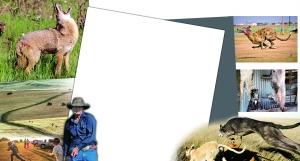
null
Quickly untying the rope, the metal cage opened with a "whoosh" sound, and several muscular hounds sped out of the truck, as if fish in a stream were flying shallow. In the high-speed running, the muscles under the thick fur of the hounds rise and fall, like the oil rushing under the velvet. They scanned the plains, stared at their prey tightly, and disappeared in an instant.
Such a sight can be seen on any day of winter in the Great Plains of the United States. As soon as dawn appeared on the horizon, hunters arrived in special trucks with hounds, targeting North American coyotes.
Coyotes are widely distributed in the North American continent, from Alaska in the north to Panama in the south, because of their adaptability, so whether in forests, swamps, grasslands or towns, people may encounter this carnivore unexpectedly. The great plains coyotes are rampant and a serious threat to livestock. In order to reduce losses, hunters hunt coyotes. But they also relish the hound's posture. "I love jumping and barking when they come out of their cages, but I love watching them gallop across the plains, and I always follow them," says Hunter Todd Fritz.
<b>Are hunters doing things for free to help the government? </b>
Coyote hunting has been on the North American continent for more than a hundred years. Large-scale coyotes have left their mark on the land to appease the grievances of farmers and farmers. Later, it gradually evolved into a pure hunting sport. The famous U.S. president Roosevelt the Elder once chased wolves from the prairie of the Western United States.
Not long ago, in order to record the custom of hunting coyotes with hunting dogs in the Great Plains, writer Eric Yassen and photographer Scott Squire made a special trip to this area. But despite being a living tradition, such a ferocious hunt for coyotes has also been condemned by animal rights activists, who call it "bloody entertainment." Some states have ordered a ban on killings under pressure, such as Colorado. But hunters there who crossed the state border to Utah would be able to kill the bounty immediately. A coyote can sell for $50 on its scalp and jaw.
In the face of accusations, hunters said they had done for free what the U.S. Department of Agriculture's Wildlife Service paid for, and in 2014 the Department of Agriculture killed 61,702 coyotes. Hunters also said the government's methods, such as poison gas and aerial shooting, were not more humane.
<b>Excellent hounds can sell for a good price</b>
In Nebraska, Lumith, Arthur and Squire saw an auction of hounds. The residents here are very traditional, and they do not need to receive receipts when trading, as long as the two sides shake hands. And if a hound has a brilliant record in wolf hunting, it can sell for a higher price.
These hounds themselves are natural sprinters, reaching as high as 72 km / h. Hunters also train them. When the hounds were young, they were given an electronically controlled neckband and taught these clever hounds that they could only chase coyotes if they saw them.
After the tuning is completed, they no longer have to wear collars, because during the high-speed running and hunting, in case the collar is hooked by a branch, the dog's neck is in danger of being torn off.
Hunters said, "It's a sport to have the hounds chase after the coyote until the result of the fight." Coyotes are the smartest wild animals on the prairie, and I respect them, they may be smarter than anyone else, but hounds are smarter. ”
<b>Hunting style slightly leads hunters to dissatisfaction</b>
As with other hunting activities, the tradition of hunting coyotes is embarrassing to the smell of animal death. Although hunters can still hunt, the tradition of hunting coyotes is waning amid their conflict with animal protection groups. Throughout the shoot, photographer Squire decided not to take pictures of coyotes being killed, "not with political aims, but by avoiding policy issues and observing this cultural tradition from the sidelines." And in the few hunts he followed, the hunters did not catch a single coyote.
Still, Squire clearly remembered a conversation he had with Hunter Todd. At first, Todd thought they were animal rights defenders in disguise, so he said tit-for-tat, "Do you want to shoot the picture of coyotes eating the newborn calves, and they tear directly into the cow's belly?"
"I've seen that," replied Squire, "and in the pictures of your hounds biting coyotes, I'm not going to shoot scenes like this either... It is also very ferocious between people, perhaps a little more benevolent than when coyotes protect territory."